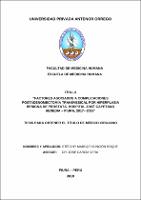Factores asociados a complicaciones postadenomectomía tranvesical por hiperplasia benigna de próstata. Hospital José Heredia-Piura, 2017-2018

Ver/
Descargar
(application/pdf: 1.226Mb)
(application/pdf: 1.226Mb)
Fecha
2019Autor(es)
Sunción Roque, Stéfany Margot
Metadatos
Mostrar el registro completo del ítemResumen
La Hipertrofia Benigna de Próstata (HBP) es un crecimiento benigno donde la próstata tiene más de 30 gr. de volumen, generando disminución del flujo urinario y síntomas obstructivos e irritativos en la micción. El tratamiento quirúrgico es adenomectomía y, en nuestro hospital, la técnica empleada es transvesical. A nivel local las complicaciones no están documentadas. OBJETIVO. Determinar los factores de riesgo asociados a complicaciones postadenomectomia Transvesical por Hiperplasia Benigna de Próstata en el Hospital III “José Cayetano Heredia”– Piura, 2017 – 2018. MATERIAL Y MÉTODOS. Estudio CASO CONTROL, retrospectivo, incluyendo al total de casos intervenidos en el periodo desde enero de 2017 hasta diciembre del 2018 y que cumplieron los criterios de selección del estudio. Se empleó software SPSS V 24.0. RESULTADOS. De las 85 Adenomectomías por HBP descartamos cinco por criterios de selección. El rango de edad de los CASOS fue entre 59 y 89 años, una media de 71,1 años y de los CONTROLES fue de 55 a 88 años, con una media de 72,2 años. Los CASOS proceden en un 80% y los CONTROLES en un 82,9% de Piura, Paita, Talara y Sullana. Según su índice de masa corporal, en el grupo de los CASOS el 73.3% tienen obesidad o sobrepeso. Más de la mitad habían sido sometidos a sondaje vesical antes de la cirugía y más de la mitad era hipertenso. Estuvieron presentes otras comorbilidades DM2, litiasis vesical y renal. El valor de PSA hasta 4ng/ml y mayor de 10ng/ml fue un 38,8% y 16,3 respectivamente. Las complicaciones post operatorias no infecciosas: incontinencia urinaria (2,5%); hematuria macroscópica postoperatoria (1,3%). Las infecciosas: ITU (21,3%); IHO (1,3%); Orquiepididimitis (1,3%). Se encontró asociación entre litiasis vesical e ITU (OR=5,3) y entre sondaje vesical previo e ITU (OR=3,61). The Benign Prostate Hypertrophy (BPH) is a benign growth where the prostate has more than 30 gr. of volume, generating a decrease in urinary flow and obstructive and irritative symptoms in urination. The surgical treatment is adenomectomy and, in our hospital, the technique used is transvesical. At the local level, complications are not documented. OBJECTIVE To determine the risk factors associated with post-procedural complications Transvesical for Benign Prostate Hyperplasia in Hospital III “José Cayetano Heredia“ - EsSalud Piura, 2017 - 2018. MATERIAL AND METHODS. Control case study, retrospective, including the total of cases serve up in the period from January 2017 to December 2018 and that met the study selection criteria. Software SPSS V 24.0 was used. RESULTS. Of the 85 Adenomectomies due to HBP, we discarded five due to selection criteria. The age range of the CASES was between 59 and 89 years, an average of 71.1 years and the CONTROLS were 55 to 88 years, with an average of 72.2 years. The CASES proceed in 80% and CONTROLS in 82.9% of Piura, Paita, Talara and Sullana. According to their body mass index, in the CASE group 73.3% are obese or overweight. More than half had undergone bladder catheterization before surgery, and more than half were hypertensive. Other comorbidities, DM2, bladder and renal lithiasis were present. The PSA value up to 4ng/ml and greater than 10ng/ml was 38.8% and 16.3 respectively. Non-infectious post-operative complications: urinary incontinence (2.5%); postoperative macroscopic hematuria (1.3%). Infectious: ITU (21.3%); IHO (1.3%); Orchiepididymitis (1.3%). An association was found between bladder lithiasis and UTI (OR=5.3) and between previous bladder catheterization and ITU (OR=3.61).
Palabras clave
Colecciones
- Medicina Humana [2969]

